The 50 Best Ghost Movies of All Time
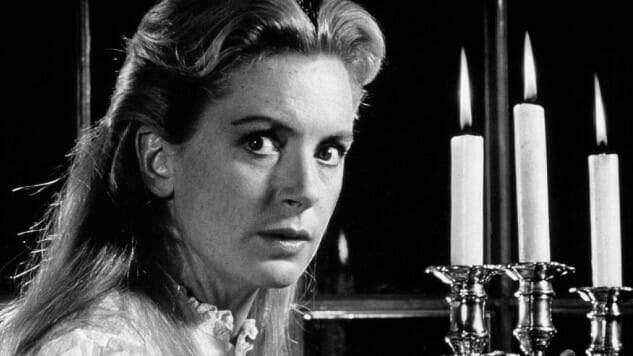
When we set out to create a list of the best “ghost movies,” we didn’t quite realize at the start exactly how diverse that list would eventually be.
We began with horror cinema in mind. Sure, there are hundreds of classical cinematic ghost stories and haunted house tales, right? They stretch back all the way back to 1944’s The Uninvited, through The Amityville Horror and onto The Conjuring and others—it’s not like there’s a shortage of malevolent spectres out there.
But then, in assembling the list, it became clear that this was another beast entirely from our recent ranking of the 50 best slasher movies of all time. Even more so than our list of the best zombie movies, “ghosts” have been co-opted into seemingly every genre, and they all belong on a list of the “best ghost movies.” After all, A Christmas Carol revolves entirely around its visiting ghosts, doesn’t it? So does Field of Dreams and its ghostly major leaguers, or the title character of Beetlejuice. So yeah, there’s plenty of horror on this list—but there’s also plenty more ghost movies suitable for fans of every genre, from romance to comedy to science fiction.
Here then, are the best ghost movies of all time:
50. Casper (1995)Director: Brad Silberling
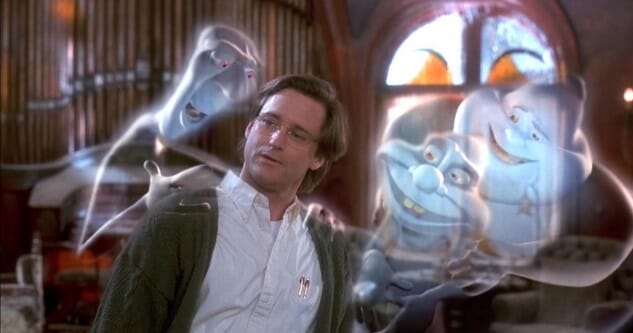
Casper is a relic of the infancy of CGI, and thus is a little strange to watch today—compared with the likes of Jurassic Park, its effects have a much harder time holding up, which renders some of its ghostly characters a bit less effective. Still, this is a memorable yarn for younger audiences, one that is surprisingly morose and mature at times in terms of its depictions of death and grief. In fact, death happens quite a bit in Casper—no surprise, I guess, in that it’s a film about ghosts, but it really stacks some bodies nevertheless. A strong cast, anchored by Christina Ricci, Bill Pullman, Brad Garrett and a wonderful Eric Idle help it rise above the muck, and even get a wee bit philosophical. You can certainly do worse for a weekend afternoon on the couch with the kids. —Jim Vorel
49. The Woman in Black (2012)Director: James Watkins
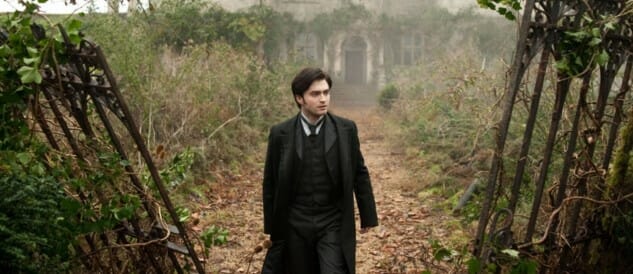
There’s not much to this 2012 modern Hammer Horror film—nothing unique about it, but it’s quite competently assembled. With that said, you could argue that simply producing a ghost story this traditional in 2012 offered a bit of novelty. Daniel Radcliffe, fresh off his final Harry Potter appearance, took a role playing “an adult” as Arthur Kipps, a Victorian era lawyer who travels to the country to negotiate the sale of a house that is revealed to be haunted by the spirit of the Woman in Black. This CGI specter has a particular fondness for targeting children, and the film becomes a mystery in the “placate this restless spirit and set her free” mold. It offers a few fun twists and turns, and evokes classic British haunted house movies of the past, as Radcliffe stalks through dark, cobwebbed rooms with a flaming candelabra to light his way. The ending is a bit derivative of Sam Raimi’s Drag Me to Hell, but all in all this is a better-than-average classical ghost story. —Jim Vorel
48. Stir of Echoes (1999)Director: David Koepp

Stir of Echoes is one of those movies where any discussion of it always tends to revolve around another film from the same year that received far more attention—in this case, that film is The Sixth Sense. Because it had the misfortune of hitting theaters a month after M. Night Shyamalan’s ghost thriller set box offices ablaze, and because it contains several of the same elements—including a young boy who can communicate with the dead—Stir of Echoes was widely derided at the time as knowingly derivative, but that assessment was never really fair. Unlike The Sixth Sense, which leans so heavily on atmosphere and tension, Stir of Echoes is more of a true popcorn thriller, a supernatural whodunit that sees Kevin Bacon descending into frothing hyperactivity after having the doors of his perception thrown wide open during a botched hypnosis session. Today, the film’s growing fandom seem to be trying to reclaim its status as an underrated horror classic, but the reality is that Stir of Echoes is an effective, classical potboiler full of themes that have been common in ghost movies for as long as we’ve had ghost movies. It does have the warm likability of Kevin Bacon going for it, though, and that’s enough to make it worthwhile. —Jim Vorel
47. Extra Ordinary (2020)Directors: Mike Ahern, Enda Loughman

It can be difficult to organically thread “romance” into horror-comedy, broadening a film to equally weigh a third major genre, but it’s the quirky relationship fodder where Extra Ordinary ultimately displays its greatest strength. This Irish indie never truly takes the frightening side of paranormal investigation seriously—it’s a true comedy all the way, and probably stronger for it—but it’s the unexpectedly quiet, thoroughly human lead performances that make it memorable. Those come from Irish actors Maeve Higgins and Barry Ward as two unassuming but uniquely talented people, imbued with abilities that allow them to touch the spirit plane rather more easily than they’re able to socialize with living, breathing humans. Higgins in particular really owns the character of Rose Dooley, imbuing her with a good-natured and immediately relatable soft-spokenness on top of an aura of melancholy that belies her ability to bring closure to spirits stuck in limbo. The scenes the two have together contain a certain warmth, a feeling that two people have been brought together who complete one another nicely—if only Ward’s ex-wife wasn’t still in the picture (in poltergeist form). Nevertheless, it’s Will Forte’s charismatic performance as washed-up prog rock star/demonic cultist Christian Winter that is likely to draw more U.S. viewers to Extra Ordinary, given that he’s the film’s most recognizable star. He makes the most of the opportunity to play another deeply eccentric character in a career that has been full of them, although his performance almost feels like something from a different movie when compared to the more grounded focus on the relationship between Higgins and Ward. That central duo, and their emerging rapport, make Extra Ordinary a heartfelt, breezy entry that gets a lot of mileage from very few moving pieces. —Jim Vorel
46. Ju-On: The Grudge (2002)Director: Takashi Shimizu
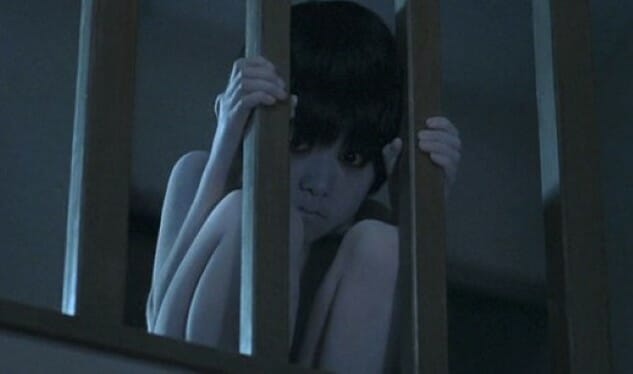
The Grudge, along with Ringu (not on Netflix streaming), are the two most prominent examples of “J-horror” (Japanese horror) from their time period to make an impact in the American psyche, as both were soon adapted into American versions. There’s nothing particularly revolutionary in its interconnected series of tales involving people menaced by the ghosts of a murdered family, but damn if its depiction of the child spirit of “Toshio” in particular didn’t become a symbol of the entire J-horror genre. Its stories of punishment may be on the conventional side, but the appearance and art direction that went into creating its creepy kid have been an undeniable influence on pretty much all the ghost movies that have come along since. —Jim Vorel
45. The Amityville Horror (1979)Director: Stuart Rosenberg
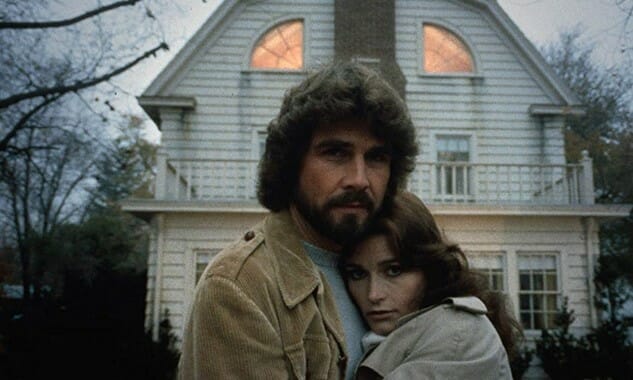
The original Amityville Horror might be one of the least striking or unique films to ever inspire more than a dozen follow-ups—seriously, there are to date 16 films that have been made with “Amityville” in the title. Its story is basic and primordial—family moves into a new house, but things go bump in the night. Every haunted house trope is well-represented, from secret rooms and unseen hands to disembodied voices and spiritual possession. If anything, the film overloads itself with concurrent, dueling reasons for the haunting, ranging from “Indian burial ground” to “site of Satanic rituals,” never really settling on a central theme. It’s just a pure popcorn haunting picture, famous for its blood-oozing walls but otherwise merely competent as your standard bit of October distraction. Perhaps it was the iconic shape of the house itself that seared itself into the cultural consciousness? No matter the reason, The Amityville Horror has been hard to shake, and has given us five new “Amityville” films in the last three years alone. —Jim Vorel
44. Mama (2013)Director: Andy Muschietti
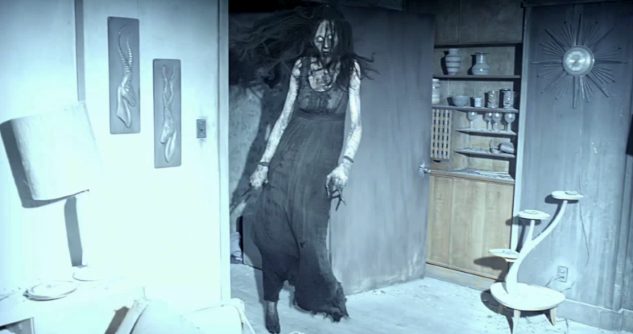
Although there’s nothing particularly original about Mama, familiar elements come together to great effect. The first shot, for example, is of a car with the door open, empty but running, the radio blaring news. It’s a visual that brims with implication, arresting in its simplicity. There are any number of classic and not-so-classic horror films that explore the inherent eeriness of children, but Andrés Muschietti manages to make the kids seem otherworldly and dangerous with just body movement and a few staging tricks. It may sound a little film-school haughty to say there’s a visual vocabulary at work in something like this, but the thought put into the composition really comes through. Muschietti also gets some solid performances out of his actors, especially Jessica Chastain. It’s hard not to sympathize with her character, Annabel, thrust into the “mother” of all bad fostering situations. —Dan Kaufman
43. The Legend of Hell House (1973)Director: John Hough
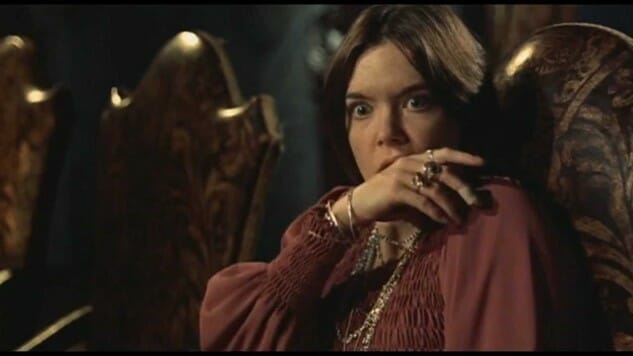
Each generation gets a haunted house movie that reflects the filmmaking mindset of the day, and for the 1970s that may well be The Legend of Hell House. Taken here is the basic format of something like House on Haunted Hill or The Haunting, with tweaks that drive it into the grindhouse era—classical spooks as informed by the work of Herschell Gordon Lewis. A doctor gathers a team of psychics to take on the evil of a haunted house, and the house doesn’t disappoint—it pretty much declares war on the characters right from the get-go, but the plot is complicated by all of the researchers simultaneously plotting against one another. There is considerable cheese factor to these proceedings; just try not to chuckle when Roddy McDowell lists the reasons for the house’s haunting as “murder, vampirism, cannibalism, drug addiction, alcoholism, sadism and mutilation,” as if everything on that list is of equal offense. Still, Hell House can boast a semi-lurid Richard Matheson screenplay, lush cinematography and nice colors for the era—a slightly exploitative twist on the standard haunted house formula. —Jim Vorel
42. 1408 (2007)Director: Mikael Håfström
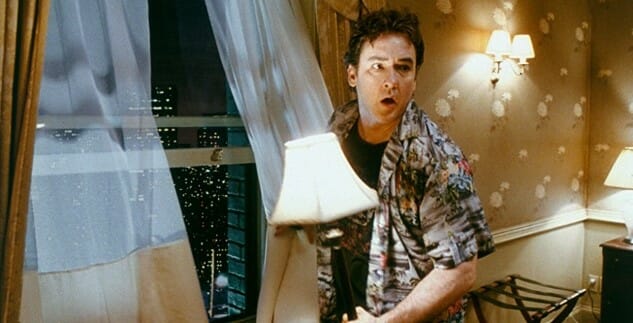
Even at its time of release, 1408 didn’t exactly command the high-profile treatment of top-tier Stephen King adaptations, but it’s a sneaky-good, high-concept ghost story all the same, and one that features one of the only John Cusack performances worth watching in the last 15 years. Cusack is playing a cynical charlatan of sorts here, a paranormal investigator and hack of a writer (a typical King protagonist!) who doesn’t believe a word of anything he’s ever written—until setting foot into Room #1408, that is. It’s a self-contained descent into madness as the evil hotel room sets its reality warping powers against Cusack, tormenting him with specters of the room’s previous victims, as well as taunting him with the demons of his own past. It all builds to a surprisingly poignant conclusion that offers some hope of peace in the afterlife—a rare case where the “theatrical ending” to a film is considerably more effective than the “director’s cut” ending included with the home video release. Breezy, entertaining and even a bit scary at times, 1408 is a well above-average example of big studio, PG-13 horror, and one that deserves credit for perfectly executing a deceptively simple premise. —Jim Vorel
41. Session 9 (2001)Director: Brad Anderson
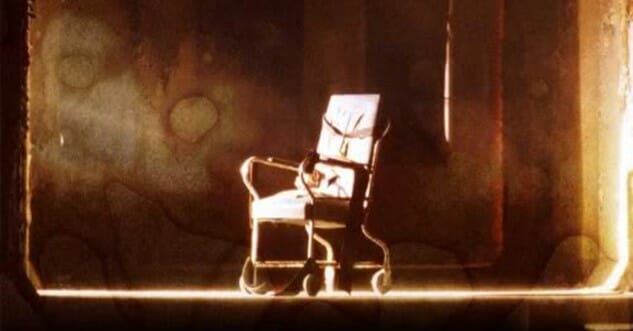
You will certainly have no trouble finding ardent supporters of Session 9 as an “overlooked gem” of a horror movie, if you dig into the online world of horror fandom. It’s often mentioned alongside the likes of Lake Mungo as an indie psychological/supernatural film that achieves a lot on a shoestring budget, but it’s also not without its faults and narrative inconsistencies. Its plot revolves around a team of asbestos removers who are clearing out an abandoned insane asylum, which might lead you to believe you know where the story is headed—rest assured, you do not. This is not a typical haunted house feature, filled to the gills with apparitions and jump-scares. Instead it’s a mind-bending, often confusing psychological thriller that is constantly asking the audience to reconsider the nature of reality and a possibly unreliable viewpoint character. Is everyone going insane? Which characters are actually alive or dead? What the hell is going on with the timeline? Session 9 is not the kind of thing you throw on in the background as idle, Halloween-season entertainment. You better sit tight and pay attention, and you might still have to come back for a second viewing in the hopes of making every thread come together. —Jim Vorel
40. Ouija: Origin of Evil (2016)Director: Mike Flanagan
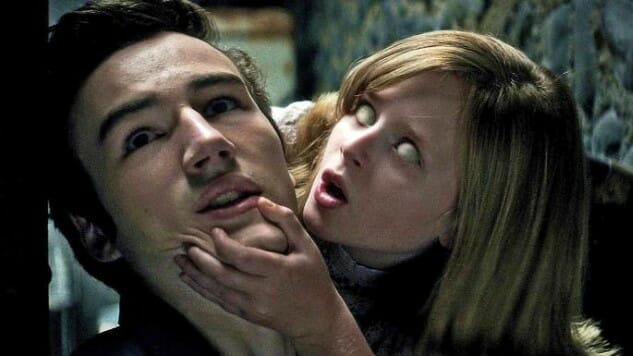
While the first Ouija was a workmanlike, paint-by-numbers cash grab without a single original touch, its prequel, directed by tried-and-true horror fan and prolific genre filmmaker (with three quality releases in 2016 alone) Mike Flanagan, bears the aesthetic of ’60s horror. From the use of the era’s Universal logo to a faded, sepia-pastel look, Origin of Evil bears witness to Flanagan having fun with the creative possibilities of the project. As intriguing as all that stuff is for genre purists and cinephiles, the whole thing would still crumble if the overall tone and performances didn’t match Flanagan’s ambitions. Thankfully, he delivers a wholly satisfying piece of PG-13 horror that deftly mixes the modern sensibilities of the genre with tried-and-true stylistic approaches from its, er, origins. —Oktay Ege Kozak
39. His House (2020)Director: Remi Weekes
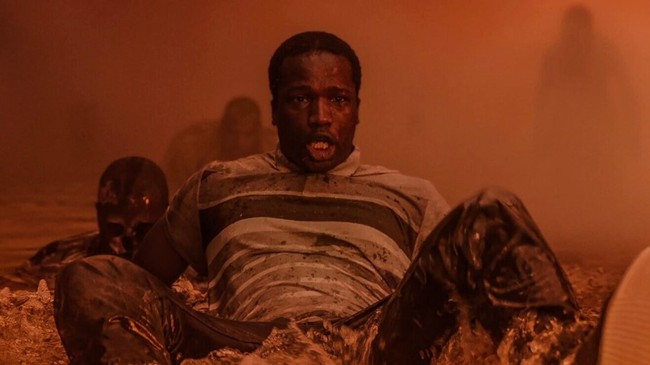
Nothing sucks the energy out of horror than movies that withhold on horror. Movies can scare audiences in a variety of ways, of course, but the very least a horror movie can be is scary instead of screwing around. Remi Weekes’ His House doesn’t screw around. The film begins with a tragedy, and within 10 minutes of that opening handily out-grudges The Grudge by leaving ghosts strewn on the floor and across the stairs where his protagonists can trip over them. Ultimately, this is a movie about the inescapable innate grief of immigrant stories, a companion piece to contemporary independent cinema like Jonas Carpignano’s Mediterranea, which captures the dangers facing immigrants on the road and at their destinations with brutal neorealist clarity. Weekes is deeply invested in Bol and Rial as people, in where they come from, what led them to leave, and most of all what they did to leave. But Weeks is equally invested in making his viewers leap out of their skins. —Andy Crump
38. The Entity (1982)Director: Sidney J. Furie

The Entity is an early ’80s supernatural thriller that certainly pushed a few buttons at the time of its release, but would likely have been forgotten all the same if it hadn’t secured one famously avowed supporter in the form of Martin Scorsese. The great director has repeatedly drawn attention to The Entity by calling it one of the scariest horror films of all time, and given the subject matter it’s not too hard to see why—the idea of being attacked, especially in a sexual way, by an invisible force is the ultimate in helplessness. Based on the real-life case of a woman named Doris Bither, who claimed to have been repeatedly attacked by the vindictive spirits of three men, it’s a squirmy knot of psycho-sexual energy that feels like a lingering entry in ’70s-era grindhouse horror, with a twist of ’80s sci-fi. Certainly not for the faint of heart, its tagline is particularly disconcerting: “Based on a true story … that isn’t over yet.” —Jim Vorel
37. A Tale of Two Sisters (2003)Director: Kim Jee-woon
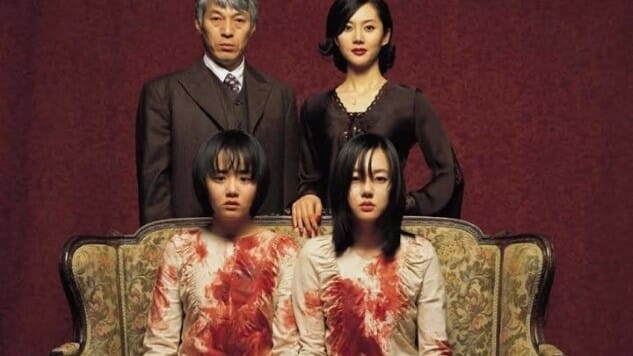
A Tale of Two Sisters is a complex, somewhat confusingly wrought Korean horror-thriller, a twisting morass of relationships and family drama that clashes against a possible supernatural threat. One of Korea’s highest-grossing horror films of all time, it combines a Hitchcockian vein of psychological/mental torture with a classical ghost story that almost invokes classic Hollywood, i.e. The Innocents or The Uninvited. It follows a pair of sisters, as the title would suggest, as the elder is released from a mental institution and back into the messed-up family dynamic that put her there. From there, the film asks many questions: What are the true motivations of the sisters’ cruel stepmother? What has been plaguing the younger sister? Is the father complicit in murder? What really happened to the sisters’ birth mother as she wasted away from illness in their now-haunted home? It’s certainly a film that almost necessitates repeated viewings, as its twisting plot development is rather tough to grasp the first time through. At times, it almost carries the world-weariness and sense of encroaching inevitability of a Shakespearean tragedy. —Jim Vorel
36. The Ghost and Mrs. Muir (1947)Director: Joseph L. Mankiewicz

Ghostly romances aren’t terribly common on this list, outside of entries that you’d expect to find such as the titular Ghost, but there are a few of merit. The Ghost and Mrs. Muir stands out as a classic ’40s romantic fantasy, following a young widower who moves with her young daughter into a seaside home, where she meets the cantankerous, rough-around-the-edges ghost of its former sea captain owner. Slowly, a most unlikely romance blooms between the two, as our protagonist (Gene Tierney) uses the life experiences of the captain (Rex Harrison) to write a best-selling memoir. It’s all fairly straightforward, replete with the kinds of “misunderstandings” and false starts you’d expect in most romances of the period, but Harrison is rather dashing as Captain Gregg, and the bittersweet ending is the stuff of Golden Age Hollywood glitz and glamor. It’s an excellent “ghost movie” for date night, provided you’re dating a historical film buff. —Jim Vorel
35. The Frighteners (1996)Director: Peter Jackson
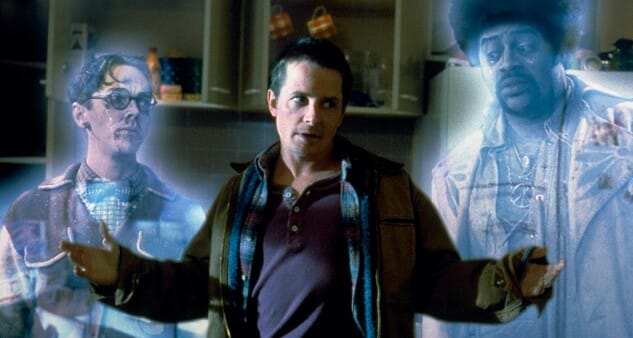
The Frighteners, along with films such as Dead Alive and Heavenly Creatures, make one wonder what kind of career Peter Jackson would have continued having had he not been tapped to bring The Lord of the Rings to life, becoming Hollywood royalty in the process. Few directors have had such a weird knack for horror and gross-out humor as early career Jackson—he’s in a company shared by the likes of early career Sam Raimi in that regard. The Frighteners was his first major film for the North American market, and it’s a weirdo blend of fantasy, horror and comedy that would likely find admiration from the likes of Guillermo Del Toro. Michael J. Fox was a blessing for Jackson to land as the lead; he gives protagonist Frank Bannister his typical charm and inherently likability in what ended up being his last feature-length leading role. It’s a tale of supernatural revenge, and one that benefits from some frenzied character acting from the likes of Jake Busey and a supremely twitchy Jeffrey Combs as an FBI agent who has been pushed far over the brink. If you do watch The Frighteners, be sure to check out the blooper clip of Michael J. Fox repeatedly calling the “Judge” character “Doc!”, to his chagrin. It’s perfectly adorable. —Jim Vorel
34. Candyman (1992)Director: Bernard Rose
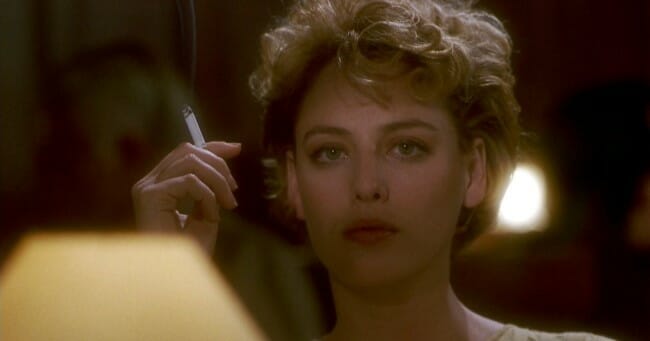
The oeuvre of Clive Barker tends to dwell on dualities and sensuality—pleasure and pain, heaven and hell, brilliance and insanity. They’re all present in Candyman, as they are in other Barker adaptations such as Hellraiser as well, forming a tangled web of romance, abuse and psycho-racial wounds. “Romance” might be an odd word to hear in this instance, but it’s appropriate—Candyman is unusual among slashers/ghost movies for its deep themes of race and taboo, especially as they pertain to sex and love. On the surface an exploration of an urban legend about the ghost of a lynched slave with a hook for a hand, on a deeper level Candyman functions as both a sumptuous gothic romance (aided by its Philip Glass score) à la Crimson Peak and a biting condemnation of government negligence and urban decay in Chicago’s poorest slums. Sometimes Candyman is noir; sometimes it’s sexy; sometimes it’s just plain gross. Tony Todd, as the titular character, has a certain mesmerizing quality that waltzes daintily on the line between farcical and terrifying, while Virginia Madsen as the protagonist actually allowed herself to be hypnotized by her director on set to properly convey the sense of falling under the Candyman’s spell. In terms of uniqueness alone, Candyman earns its own strange, little corner in the slasher (and ghostly) canon. —Jim Vorel
33. The Fog (1980)Director: John Carpenter
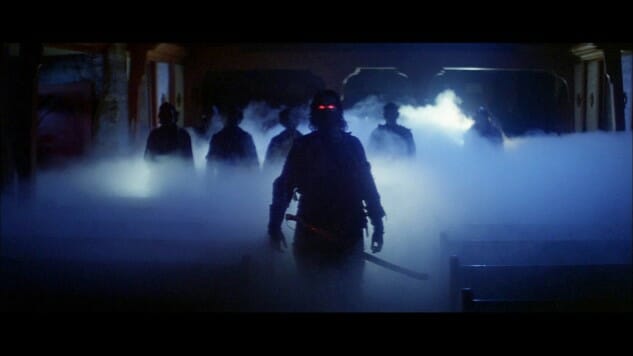
If you’re a horror fan, it’s hard not to love the basic premise of The Fog, with its billowing clouds of white vapor that bring swift death along with them. John Carpenter’s follow-up to Halloween had a somewhat larger budget to work with, and the practical effects look great as a result, although it wasn’t as successful at the box office. Regardless, The Fog is a superior film from a production standpoint, reuniting Carpenter with Jamie Lee Curtis, albeit in a less important role. It concerns a Californian coastal town that is celebrating its 100th anniversary when dark secrets from the 1800s begin to emerge. Turns out that the “city fathers” committed some pretty serious crimes against humanity, and now a crew of restless revenants has returned to dish out some much-deserved revenge. Caught up in the madness is Adrienne Barbeau, Carpenter’s wife of the time, debuting on screen in the role that would make her a scream queen figure for decades. There’s simply a great sense of atmosphere in The Fog, especially in the dense, otherworldly way that the glowing banks of fog move throughout town, amplified by a signature John Carpenter synth soundtrack. Anyone who knows Carpenter would be able to pick out his unique style immediately. —Jim Vorel
32. Ghost (1990)Director: Jerry Zucker

In the “friendly ghost stuck in the earthly plane with unfinished business” camp, Patrick Swayze’s 1990 star vehicle Ghost also has elements of romance, comedy, mystery, and extreme early 90s cheesiness (wow, those special effects are mind-boggling). But for all its earnestness and overuse of tight shots of Demi Moore shedding tears, there’s something lovable about it. Is it the tastiness of the idea that people taken from our lives before their time might indeed still be accessible, might even be watching over us? Is it the parody-provoking yet oddly heart-tugging use of the Righteous Brothers’ gorgeous recording of “Unchained Melody?” Is it Whoopi Goldberg’s annoying yet hilarious turn as a fraud psychic who is terrified when she finds herself actually channeling a ghost? Every time you want to write this movie off, something genuinely sweet or genuinely intriguing or genuinely funny reels you back in. Every time you get reeled back in you find yourself thinking “Why am I watching this?” It’s dated, and it’s no auteur tour de force but it has a certain lightness of … well, yeah, of spirit. Get a glass of wine, ignore the special effects demons and just go along for the ride as Patrick Swayze avenges his own murder and finds the most elusive ghost of all: closure. —Amy Glynn
31. House on Haunted Hill (1959)Director: William Castle
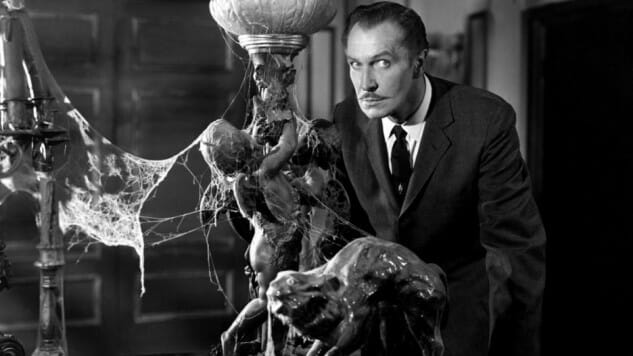
Every William Castle movie has its own campy charms, but House on Haunted Hill is the guy’s masterpiece. It’s got it all: Vincent Price at his goofiest, a big spooky house, a mystery and a profoundly non-frightening walking skeleton. The gimmick this time around was referred to by Castle as “Emergo,” and it amounted to a plastic skeleton on a pulley system being flown over the audience—not his most creative, but shameless enough that only Castle would stoop so low. To me, this is the quintessential 1950s horror film, even though it comes at the end of the decade. It’s totally tame by today’s standards but has some fun, over-the-top performances, a bit of witty dialog and a large helping of cheese. I can watch this thing over and over without ever getting tired of it. It’s like horror comfort food. The colorized version is even more fun, replacing the static black-and-white original with an unrealistic palette of color-coded characters you will remind you of the cast of Clue. —Jim Vorel
30. The Innkeepers (2011)Director: Ti West
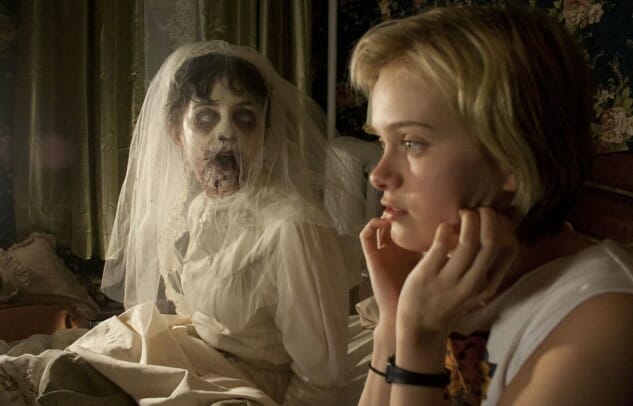
When you’re working in indie horror, a big part of success is learning how to turn your budgetary limitations into a positive—to rely less heavily on effects and setting and more on characterization and filmcraft. Ti West understands this better than most, which is part of what made his earlier House of the Devil so effective. The Innkeepers has some of the same DNA, but it’s rawer and more “real,” following the mostly unremarkable exploits of two friends (Sara Paxton and Pat Healy) as they work in a dingy old bed & breakfast and conduct nightly paranormal research in their place of business. They’re well-cast and feel like two of the most “real people” you’re likely to see in a horror film—West, acting in moments like a horror-tinged Tarantino, enjoys lingering on them during their conversations and small-talk, which builds a sense of casual camaraderie to what are supposed to be long-time co-workers. Of course, things do eventually start going bump in the night, and the film ratchets up into a classically inflected ghost story. Some will accuse it of being slow, or of spending too much time dawdling with things that are unimportant, but that’s “mumblegore” for you. Ultimately, the reality imbued into the characters justifies the time it takes to give them characterization, and you still get some spooky “boo!” moments in the film’s final act. —Jim Vorel
29. Under the Shadow (2016)Director: Babak Anvari
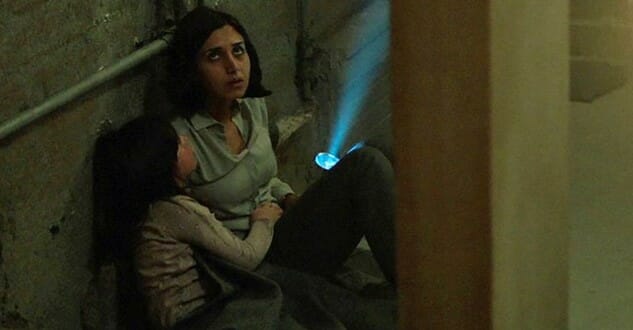
For most of the film, Babak Anvari is crafting a stifling period drama, a horror movie of a different sort that tangibly conveys the claustrophobia of Iran during its tumultuous post-revolution period. Anvari, himself of a family that eventually fled the Ayatollah’s rule, has made Under the Shadow as statement of rebellion and tribute to his own mother. It’s a distinctly feminist film: Shideh (Narges Rashidi) is cast as the tough heroine fighting back against greater hostile forces—a horror movie archetype that takes on even more potency in this setting. Seeing Shideh defy the Khomeini regime by watching a Jane Fonda workout video, banned by the state, is almost as stirring as seeing her overcome her personal demons by protecting her child from a more literal one. —Brogan Morris
28. Hausu (1977)Director: Nobuhiko Obayashi
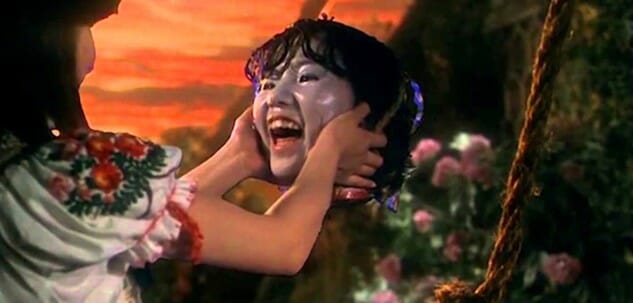
Oh, how to describe Hausu? Anyone who has seen this crazed Japanese mishmash of horror, comedy and fantasy knows this is no easy task—it’s simultaneously as simple as saying “It’s about some girls who go to a haunted house,” and much more complicated. Hausu has often been described as being “like Jaws, but with a house,” but the comparison isn’t exactly accurate—where Spielberg’s film is classic adventure, Obayashi’s is like a bad acid trip, sporting trippy, day-glo color schemes and mind-bending visuals. Animated cats, disembodied flying heads and stop-motion monsters are all par for the course as Hausu goes for the jugular, seemingly trying to overwhelm the viewer with an all-out assault on the senses. As a piece of modern camp spectacle it’s top tier, but it would be a shame to overlook the genuinely imaginative visual effects and how they would seem to presage the likes of Evil Dead 2 in the years to come. If there’s another film where a woman is eaten by a living, evil piano, I haven’t yet seen it. —Jim Vorel
27. The Conjuring (2013)Director: James Wan

Let it be known: James Wan is, in any fair estimation, an above average director of horror films at the very least. The progenitor of big money series such as Saw and Insidious has a knack for crafting populist horror that still carries a streak of his own artistic identity, a Spielbergian gift for what speaks to the multiplex audience without entirely sacrificing characterization. Several of his films sit just outside the top 100, if this list were ever to be expanded, but The Conjuring can’t be denied as the Wan representative because it is far and away the scariest of all his feature films. Reminding one of the experience of first seeing Paranormal Activity in a crowded multiplex, The Conjuring has a way of subverting when and where you expect the scares to arrive. Its haunted house/possession story is nothing you haven’t seen before, but few films in this oeuvre in recent years have had half the stylishness that Wan imparts on an old, creaking farmstead in Rhode Island. The film toys with audience’s expectations by throwing big scares at you without standard Hollywood Jump Scare build-ups, simultaneously evoking classic golden age ghost stories such as Robert Wise’s The Haunting. Its intensity, effects work and unrelenting nature set it several tiers above the PG-13 horror against which it was primarily competing. It’s interesting to note that The Conjuring actually did receive an “R” rating despite a lack of overt “violence,” gore or sexuality. It was simply too frightening to deny, and that is worthy of respect. —Jim Vorel
26. Oculus (2013)Director: Mike Flanagan
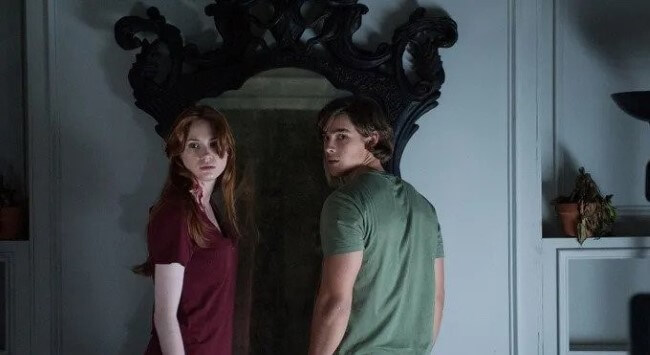
When one hears that the central focus point of Oculus is a haunted mirror, you expect a fairly self-contained ghost story, but this recent release proved to be a surprisingly ambitious concept from a promising horror director, Mike Flanagan. It simultaneously juggles accounts of the mirror’s evil influence in two timelines, following the same characters as children and adults. The segments as children feel a tad by-the-books, but the pleasantly over-the-top performances in the adult portion are particularly enjoyable, as a young woman attempts to scientifically document and then seek revenge upon the source of her family’s misery. The film begins to peter out just a bit by the end, as the two stories become intertwined to the point of confusion in an attempt to blur the lines of reality, but in general it’s a stylish, creepy horror flick that goes out of its way to defy conventions. Look no further than the soul-sucking ending, which leaves the door wide open to all sorts of future possibilities if Flanagan ever wants to revisit the concept. —Jim Vorel
25. Ringu (1998)Director: Hideo Nakata
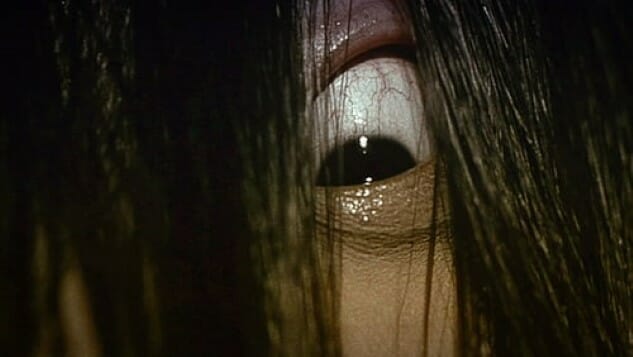
The Hollywood remake of Ringu decided to use spectacle where Nakata’s understated original used simple, bone-deep dread. The latter is a less visceral experience, but a far, far more unsettling one. Opening on the deadly haunting of a teen girl, the film then follows Asakawa (Nanako Matsushima), a local TV reporter who files stories about urban legends. Trouble is, the campfire story about the VHS tape that curses you with death in seven days isn’t just a story. Filled with arresting imagery, chilling sound design, and cinematography that conveys the fear and paranoia of its doomed and desperate protagonists, it is easy to see why this progenitor of the “J-horror” genre took the West by storm. —Kenneth Lowe
24. Grave Encounters (2011)Directors: Colin Minihan and Stuart Ortiz, “The Vicious Brothers”
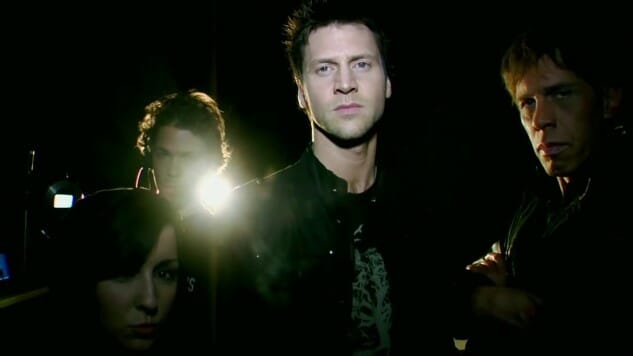
It’s hard to understand why Grave Encounters doesn’t have a better reputation among horror geeks, who largely seem to be aware of it but deride the found-footage movie as either derivative or cheesy. In our own estimation, it’s one of the best found footage offerings of the last decade, and certainly one of the most legitimately frightening, as well as humorous when it wants to be. It’s structured as a pitch-perfect parody of inane TV ghost-hunting shows, in the style of Travel Channel’s Ghost Adventures, and imagines the satisfying results of what might happen when one of these crews full of charlatans is subjected to a genuinely evil location. But Grave Encounters goes beyond what is expected of it—you hear that premise and expect some frantic, handicam running around and screaming in the dark, but it delivers far more. The FX work, on a small budget, is some of the best you’re ever going to see in a found-footage film, and the nature of the haunting is significantly more mind-bending and ambitious than it first appears. We’ll continue to defend this film, although you should steer clear of the less inspired sequel. —Jim Vorel
23. Carnival of Souls (1962)Director: Herk Harvey
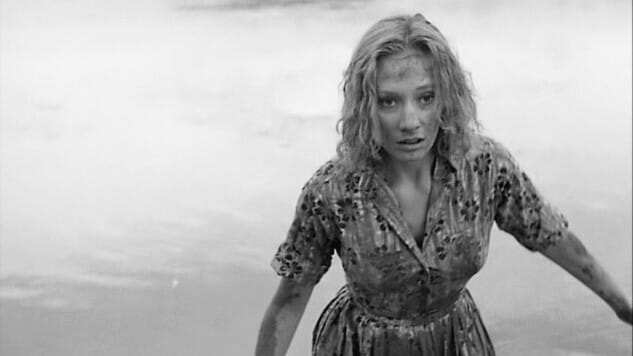
Carnival of Souls is a film in the vein of Night of the Hunter: artistically ambitious, from a first-time director, but largely overlooked in its initial release until its rediscovery years later. Granted, it’s not the masterpiece of Night of the Hunter, but it’s a chilling, effective, impressive little story of ghouls, guilt and restless spirits. The story follows a woman (Candace Hilligoss) on the run from her past who is haunted by visions of a pale-faced man, beautifully shot (and played) by director Herk Harvey. As she seemingly begins to fade in and out of existence, the nature of her reality itself is questioned. Carnival of Souls is vintage psychological horror on a miniscule budget, and has since been cited as an influence in the fever dream visions of directors such as David Lynch. To me, it’s always felt something like a movie-length episode of The Twilight Zone, and I mean that in the most complimentary way I can. Rod Serling would no doubt have been a fan. —Jim Vorel
22. The Canal (2014)Director: Ivan Kavanagh
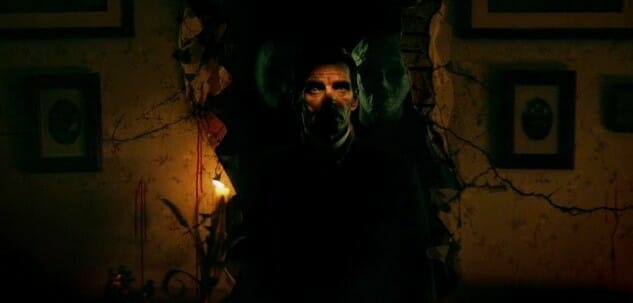
This indie Irish horror film announces Ivan Kavanagh as a serious talent and remarkably skilled director—it’s the kind of film you might watch on a streaming service with zero expectations, only to be completely blown away. Nominally a “ghost story” of sorts about a man who discovers a century old grisly crime that occurred in his house, it’s actually much more of a psychologically intense minefield—the sort of film that Polanski would have made, if there actually were ghosts in Repulsion. Combining elements that remind one of The Shining’s superb sound design with the surrealist, red-and-blue color palette of a film by Dario Argento, it is impeccably put together and beautiful to look at. The story, unfortunately, gets just a little bit too literal and wraps things up a bit neatly in the last 15 minutes, but the movie crafts an extremely effective web of dread and genuine fear through its entire runtime. Here’s hoping that we see another horror film from Kavanagh at some point. —Jim Vorel
21. Crimson Peak (2015)Director: Guillermo del Toro

Crimson Peak is a deeply human picture where the ghouls shuffling in the back of del Toro’s mind happily serve as window dressing instead of as antagonists. People, not monsters, have always been del Toro’s central fascination. He just happens to have a pronounced fetish for all things ectoplasmic and phantasmagoric, though his supernatural tastes match his preference in thespians. Here, he has assembled the comely trio of Mia Wasikowska, Tom Hiddleston and Jessica Chastain to play out his film’s mortal conflicts, which makes good sense: In del Toro’s world, the dead necessarily look just as stunning as the living. Sue the man for placing high aesthetic value on the visual scheme of the fiends haunting his pictures. Like The Devil’s Backbone, used here as del Toro’s self-reference point, Crimson Peak takes the “haunting” part to heart, with a ghost yarn wrapped up in Victorian-era romance that’d make du Maurier, Brontë, Bava, and Perrault beam with pride from beyond the grave. —Andy Crump
20. A Christmas Carol (1984)Director: Clive Donner
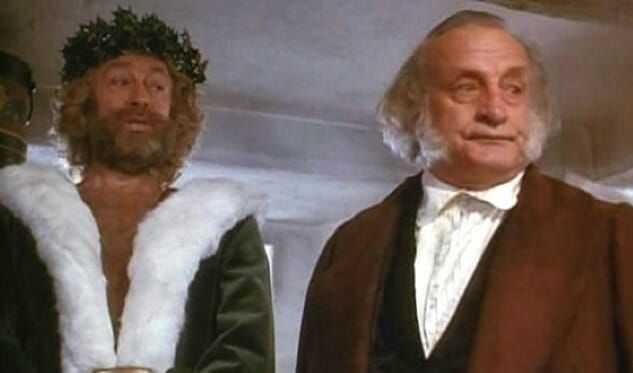
It wasn’t so much a question of whether A Christmas Carol belonged on a “ghost movies” list (the ghosts drive the whole story!), but which version to choose, it being a tale that has been told on screen so many times. There’s innumerable good options to choose from, from the 1951 classic with Alastair Sim, to the Muppets rendition, to the surprisingly good TV version in 1999 with Patrick Stewart. But we decided to go with the George C. Scott version, because really, what other actor seems so perfectly born to play the cantankerous old Ebenezer Scrooge than Scott, he of the perpetual sour face? This Christmas Carol is a happy middle ground between versions—more accessible (and spookier) than the Alastair Sim one, and more serious-minded than The Muppets, although that’s always a good time. True to Dickens’ original story, and with the perfect Ebenezer behind it, this is as close to the definitive version of the tale as we’ve yet come. —Jim Vorel
19. The Uninvited (1944)Director: Lewis Allen
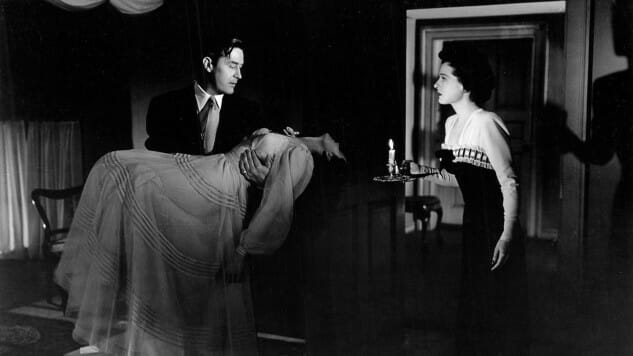
There are no shortage of “ghost stories” in the cinematic encyclopedia that hail from before 1944, but The Uninvited threw a significant wrench into convention by making the somewhat risque (at the time) decision of ultimately portraying its own haunting as real. Before this point, ghosts and hauntings in movies were typically revealed as the work of charlatans, Scooby Doo-style, but The Uninvited instead took these gothic trappings and welded them to an emotionally affecting family mystery/drama. The action takes place at a seaside mansion that has been home to violence in the past, and threatens to be again, as the descendents of the original victims (and perpetrators) return to have the sins of their forebears visited upon them. Classical, spooky cinematography give the film an air of refinement, similar to what you’d see in Val Lewton’s Cat People or 1961’s The Innocents. —Jim Vorel
18. The Others (2001)Director: Alejandro Amenábar
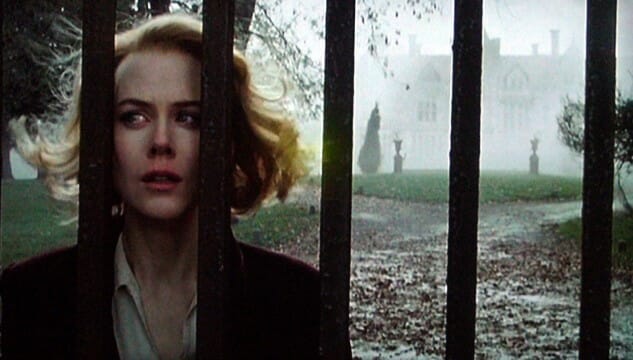
The Others is a stately ghost thriller that is classical in structure, sumptuous in appearance and somewhat familiar in its plotting. Borrowing heavily from the modus operandi of gothic horror literature and Hammer horror productions of the ’60s, it’s hard not to look at Nicole Kidman here and see her as doing an impersonation of Deborah Kerr in The Innocents, except playing a mother rather than “governess.” Still, The Others takes the bones of that kind of story, in the mold of The Turn of the Screw and adds a few more modern layers—an absent husband who mysteriously returns; a pair of servants who seem to know more than they let on; a few genuinely creepy scenes involving the children. It was rightly praised upon release as a stylish throwback in an era that was considerably more dominated by monsters and slashers, and its period piece setting gives it a certain timeless quality, 20 years later. The best ghost stories age well, and The Others is doing exactly that. —Jim Vorel
17. Lake Mungo (2008)Director: Joel Anderson

And speaking of found footage, here’s another entry in the genre that has had considerably more positive critical attention. Lake Mungo could scarcely be more different from something like Grave Encounters—there are no ghosts or demons chasing screaming people down the hall, and it’s chiefly a story about family, emotion and our desire to seek closure after death. You could call it a member of the “mumblegore” family, without the gore. It centers around a family that has been shattered by a daughter’s drowning, and the family’s subsequent entanglement in what may or may not be a haunting, and the mother’s desire to determine what kind of life her daughter had been living. Powerfully acted and subtly shot, it’s a tense (if grainy) family drama with hints of the supernatural drifting around the fraying edges of their sanity. If there’s such a thing as “horror drama,” this documentary-style film deserves the title. —Jim Vorel
16. Field of Dreams (1989)Director: Phil Alden Robinson
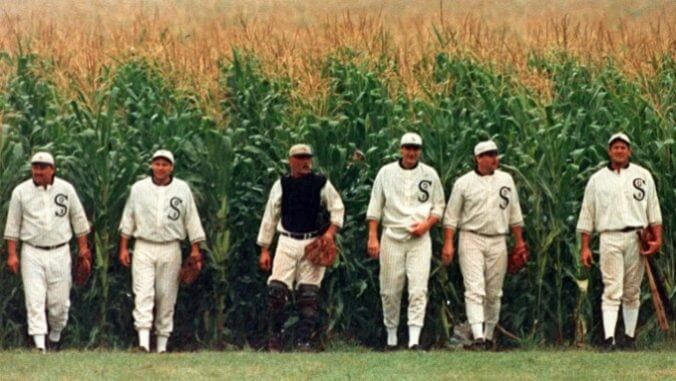
There’s a little fantasy in most sports dramas, overcoming impossible obstacles and peaking at the magical moment to carry the day. But Field of Dreams, adapted from W.P. Kinsella’s novel Shoeless Joe, isn’t a story of athletic prowess or winning the day. It’s a story of believing in the magic of sports. It’s a story of fathers and sons, of the hard work of play, of disconnecting from the worries of the real world to play a game of catch. In other words, it’s about baseball, the only sport that can turn an Iowa cornfield into a little slice of heaven. Of course Kevin Costner and James Earl Jones’ buddy journey to belief is sentimental; America’s pastime is nothing without sentiment. The major leagues may wish that all it took was new state-of-the-art taxpayer-subsidized sports complexes outside of their traditional downtown locales to spike attendance, but in 1989 we all believed. “If you build it, they will come…” —Josh Jackson
15. A Ghost Story (2017)Director: David Lowery
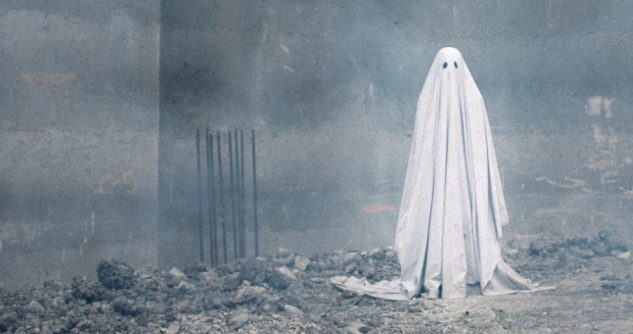
Turns out the perfect opportunity for an existential dilemma is when you no longer exist. With a cheeky title like A Ghost Story, it’s no surprise that David Lowery’s movie isn’t a typical tale of paranormal activity—but even that won’t prepare you for the film’s unpredictable, emotional odyssey through love, death, longing and time. It might even be one of the most epic sub-90-minute movies ever made. In it, Casey Affleck and Rooney Mara star as a couple, perhaps married, identified in the credits as C and M, respectively. They live in a simple, old house. He’s attached to it, she wants to move. We get a sense of friction because of that conflict, but we’re also offered genuine affection, especially when the two cuddle after a startling bang on C’s piano wakes them in the middle of the night. Then, just as we’re getting to know them via mumbled dialogue and C’s songwriting, he dies unexpectedly in a car accident. In the aftermath, the movie takes its time to reveal its bold intentions. Writer/director Lowery is already comfortable with both indie projects (Ain’t Them Body Saints) and high-profile Disney joints (2016’s Pete’s Dragon). Perhaps this success has given him the freedom to do a small, low-budget film and not worry about whether people will call it pretentious or boring. A Ghost Story’s dialogue is quiet and sometimes hard to make out, takes are long and deliberate, and the cinematography is muted, not to mention in the out-of-favor (albeit still used) 1.37:1 Academy aspect ratio. With these elements, Lowery captures time in its vastness and loneliness—because it is, after all, the most dramatic difference between the living’s and the dead’s points of view, something that’s taken for granted in most movies (pacing problems and flashbacks aside). C, of course, “wakes up” from death as a sheet-festooned ghost, for whom time becomes more and more significant as he lingers, and as the camera lingers along with him. A Ghost Story isn’t a haunting so much as a witnessing. —Jeremy Mathews
14. We Are Still Here (2015)Director: Ted Geoghegan
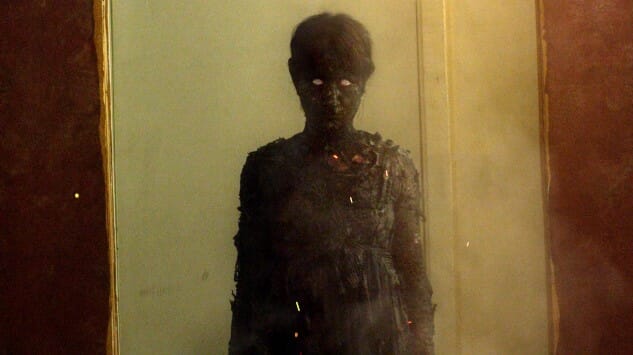
We Are Still Here never wants for scares. It might actually be the single most terrifying movie of 2015, even next to David Robert Mitchell’s acclaimed and unsettling It Follows. But Geoghegan handles the transition smoothly, from the story of running away from tragedy We Are Still Here begins as to the bloodbath it becomes. There’s no sense of baiting or switching; the director flirts with danger confidently throughout. Plus, there’s that New England winter to add an extra layer of despair. The elements forebode and forbid in equal measure. The weather outside is frightful … and the carbonized wraiths in the basement even more so. In the end, this is one haunted house that won’t be denied. —Andy Crump
13. The Beyond (1981)Director: Lucio Fulci
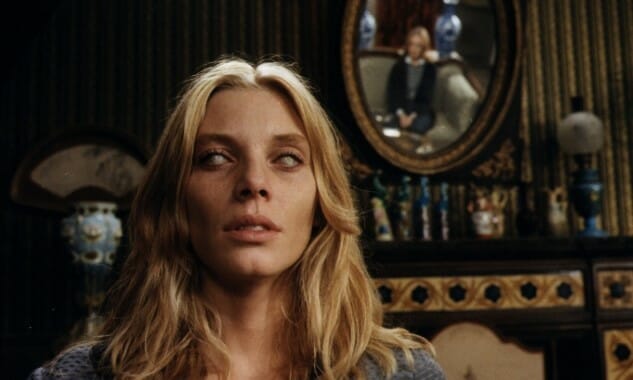
The Beyond may be the best of Lucio Fulci’s non-zombie movies. Which isn’t to say there aren’t any zombies in it, but it’s not a Romero-style zombie movie, like the former. The Beyond is the middle entry in Fulci’s “Gates of Hell” trilogy, and takes place in and around a crumbling old hotel that just happens to have one of those gates to Hell located in its cellar. When it opens, all Hell—of course—starts to break loose in the building, in a film that combines a haunted house aesthetic with demonic possession, the living dead and ghostly apparitions. As with so many of the other films in this mold, it’s not always entirely clear what’s going on—and honestly, the plot is more or less irrelevant. You’re watching it to see demons gouge people’s eyes out or watch heads being blown off, and there’s no shortage of either. Thinking back to Lucio Fulci movies after the fact, you won’t remember any of the story structure, you’ll just remember the ultra gory highlights, splattering across the screen in a way that continues to influence filmmakers to this day. —Jim Vorel
12. Personal Shopper (2017)Director: Olivier Assayas
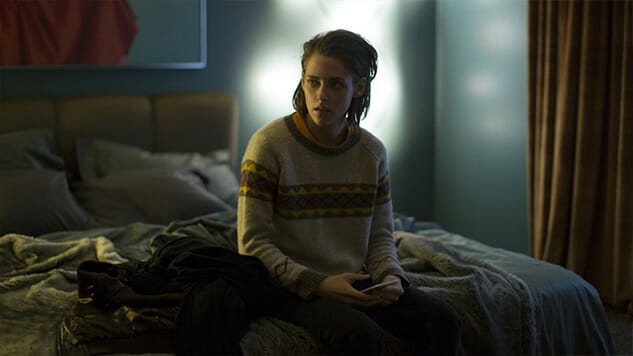
The pieces don’t all fit in Personal Shopper, but that’s much of the fun of writer-director Olivier Assayas’s enigmatic tale of Maureen (Kristen Stewart, a wonderfully unfathomable presence), who may be in contact with her dead twin brother. Or maybe she’s being stalked by an unseen assailant. Or maybe it’s both. To attempt to explain the direction Personal Shopper takes is merely to regurgitate plot points that don’t sound like they belong in the same film. But Assayas is working on a deeper, more metaphorical level, abandoning strict narrative cause-and-effect logic to give us fragments of Maureen’s life refracted through conflicting experiences. Nothing happens in this film as a direct result of what came before, which explains why a sudden appearance of suggestive, potentially dangerous text messages could be interpreted as a literal threat, or as some strange cosmic manifestation of other, subtler anxieties. Personal Shopper encourages a sense of play, moving from moody ghost story to tense thriller to (out of the blue) erotic character study. But that genre-hopping (not to mention the movie’s willfully inscrutable design) is Assayas’s way of bringing a lighthearted approach to serious questions about grieving and disillusionment. The juxtaposition isn’t jarring or glib—if anything, Personal Shopper is all the more entrancing because it won’t sit still, never letting us be comfortable in its shifting narrative. —Tim Grierson
11. The Orphanage (2007)Director: J.A. Bayona

It seems safe to say that director J.A. Bayona was more than a little influenced by Guillermo Del Toro’s The Devil’s Backbone when he laid out The Orphanage, but the film also channels a more stately, gothic brand of horror rather than the dusty, dingy realism of Del Toro’s Spanish Civil War ghost story. Here we have something with a bit more grandeur—a crumbling, seaside mansion that would look out of place if it didn’t have a ghost. Belén Rueda is fantastic as Laura, a woman who moves into the orphanage where she grew up with her husband and young son, before being drawn into the secret history of both the house and the other former orphans who once lived there alongside her. Deep-seated emotion and the impossible desire to protect loved ones from the inevitable permeate the film, but once the home’s restless spirits become active, it’s also quite chilling. Tomás (Oscar Casas), the sack-masked young boy you’ll no doubt see on the DVD cover of The Orphanage, cuts an iconic figure among child ghosts, but it’s the things left unseen that make The Orphanage chilling. The scene featuring a reprise of the knock-knock game once played by the orphans is almost unbearably tense. —Jim Vorel
10. Beetlejuice (1988)Director: Tim Burton
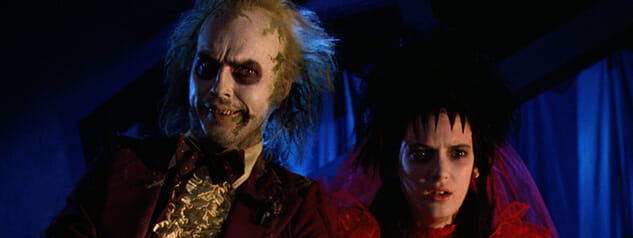
After a little vacation, Barbara and Adam Maitland find some uninvited guests in their homes. Okay, so maybe they died, and maybe their house was sold to some poor, unsuspecting (but equally annoying) couple—that doesn’t mean Geena Davis and Alec Baldwin have to like it. After some failed haunting attempts, the Maitlands make the mistake of hiring a “bio-exorcist” Betelgeuse (played perfectly by a never-more-revolting Michael Keaton) to fumigate the place of the living. As this situation tends to go, the hired gun gets out of control, and we’re left with Tim Burton’s wacky vision of a ghoul gone really bad. Its good humor and (sort of) likable antagonist make this one the rare cinematic ghost story that most of the family can enjoy, although Keaton certainly tosses out a few veiled adult jokes for the ages. —Tyler Kane
9. The Sixth Sense (1999)Director: M. Night Shyamalan
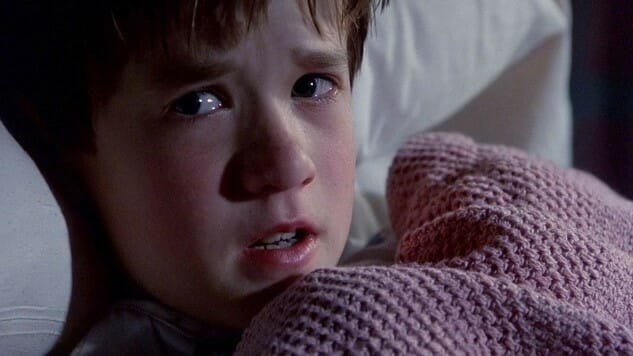
Featuring great performances by Bruce Willis and Haley Joel Osment, along with a legitimately chilling atmosphere, The Sixth Sense was nothing short of a phenomenon when it hit multiplexes in 1999. Critical examination aside, it truly is a frightening film, from the scene where Cole is locked in a box with an abusive ghost to the little moments (I always found the scene where all the kitchen cabinets and drawers open at once while off-screen to be particularly effective). For better or worse, though, this is the defining film of M. Night Shyamalan’s career, and its success was a double-edged sword: It bestowed the “brilliant young director” label on him, but also pigeonholed his personal style as a writer to the extent that his next five features at least were all reshaped by the aftershocks of The Sixth Sense. Rarely has the danger of success been so clearly illustrated for an artist—Shyamalan crafted a scary film that still holds up today, and then spent most of the next decade chasing that same accomplishment with rapidly diminishing returns that have only recently been rehabilitated with the likes of Split. —Jim Vorel
8. The Devil’s Backbone (2001)Director: Guillermo Del Toro
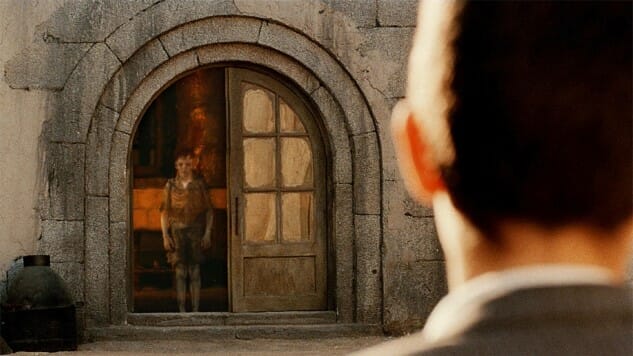
Guillermo Del Toro’s Pan’s Labyrinth has been widely celebrated as one of the Mexican fantasist’s most beautifully macabre masterpieces, but it was that movie’s earlier “sister film,” The Devil’s Backbone, that was his most chilling (and personal) work in the horror genre. Against a similar backdrop of the Spanish Civil War, and again told from the perspective of a young child (Fernando Tielve), The Devil’s Backbone is less about escaping from a world of horrors via either imagination or the existence of a faerie realm, and more about confronting those personal terrors in the starkness of reality and with all the limitations of being virtually powerless. Santi, the young ghost haunting this Spanish orphanage, is a mystery, a cipher whose desires are alien to us, brackish as the ghostly water consistently weeping from his wounds. Slowly ratcheting up the tension as an unexploded bomb from the war merrily ticks away in the courtyard as a living memento of the violence around them, The Devil’s Backbone combines some of the chilling, ghostly scares of J.A. Bayona’s The Orphanage with the sense of childhood secrecy and pacts that Del Toro understands so well (a la Stephen King). It remains his purest horror film. —Jim Vorel
7. Ghostbusters (1984)Director: Ivan Reitman

As the slew of ’80s merchandise and a cartoon series would prove, Ghostbusters had mass-appeal with kids. The film followed a team of parapsychologists—played by Dan Aykroyd, the late Harold Ramis, Ernie Hudson and Bill Murray—who tackle big-ghost issues in New York City. Sure some of the effects are dated, but this one has staying power, and near-infinite quotability. And although the bad guys come from beyond the grave, they’re also kid-friendly, with the begging-to-be-a-plush-toy Slimer and a giant Stay-Puft Marshmallow Man. Pass this classic comedy along to the next generation, while more or less ignoring the middling remake, which was neither as good or bad as fans or detractors made it out to be. —Tyler Kane
6. The Changeling (1980)Director: Peter Medak
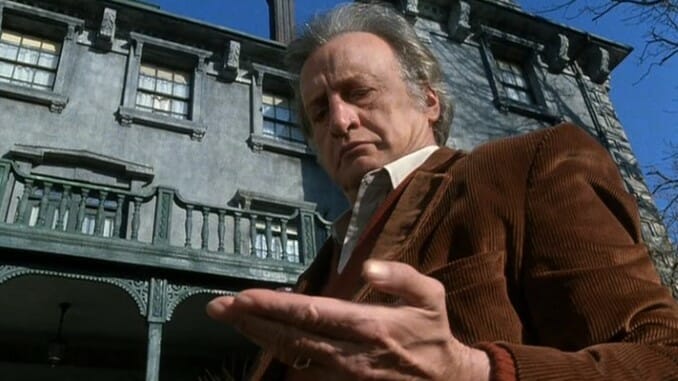
George C. Scott tempers his natural irascibility to play a melancholy composer grieving for his recently deceased wife and daughter in Peter Medak’s conflation of haunted house movie and supernatural whodunit. Dubbed one of the scariest movies of all time by Martin Scorsese, The Changeling deals the terror out in spades, with Medak playing up the tightening fear of the unknown with the precision of a horror maestro. (Indeed, it’s amazing Medak had never even been near the genre before.) Having moved into a new home, a century-old manor also occupied by the restless spirit of a young boy, Scott’s John Russell digs to discover the tale of an institutional cover-up, and of power wielded monstrously in the name of financial gain. The Changeling may be a showcase for an effortlessly magnetic veteran lead, but it’s also a mystery thriller that engrosses as it frightens. What begins as another haunted house story ends as a commentary on the history of America: a nation built not just on hard work, but also on blood and not-always-heroic sacrifice. —Brogan Morris
5. The Haunting (1963)Director: Robert Wise
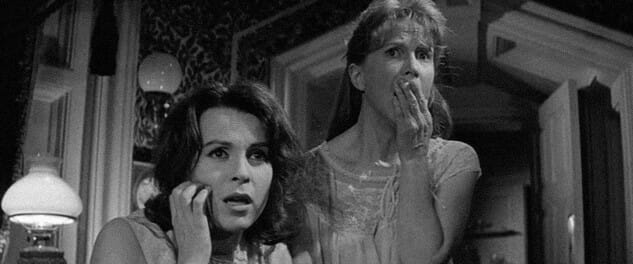
Director Robert Wise purportedly hoped to experience paranormal phenomena during the filming of this adaptation of a Shirley Jackson novel, and disappointingly never did. Nonetheless he left viewers with a fairly chilling and highly stylish imagined experience. Anthropology professor Dr. John Markway (Richard Johnson) investigates reports of psychic phenomena at the spooky New England mansion called Hill House. His entourage consists of two ESP-gifted-but-very-different-women, Eleanor and Theodora (Julie Harris and Claire Bloom, respectively), as well as skeptic and Hill House heir Luke Sanderson (Russ Tamblyn). Johnson and Tamblyn both give great performances, but the heart of the film is the high-voltage and high-contrast acting by Harris and Bloom, who both respond to the house’s various presences in very different ways. Wise creates a tapestry of unease and suspense with an allusive, suggestive directorial style that leaves a lot of room for speculation as to how much of what we’re witnessing is genuinely paranormal and how much is driven by the distorted perceptions of the troubled characters—especially of Harris’s Eleanor, a distraught caregiver desperate to escape the clutches of her overbearing family. Wise, along with cinematographer Davis Boulton, uses wide-angle lenses and infrared photography, as well as incredibly creepy sets, to create a sense of unreality and distortion; unexpected angles serve to keep us off-kilter. In turn, The Haunting is a gooseflesh-inducing study in detachment from reality and a masterful deployment of ambiguity. The ghostly phenomena might be real or might be in the characters’ heads, and the sense of uncertainty is what creates profound unease. —Amy Glynn
4. Poltergeist (1982)Director: Tobe Hooper
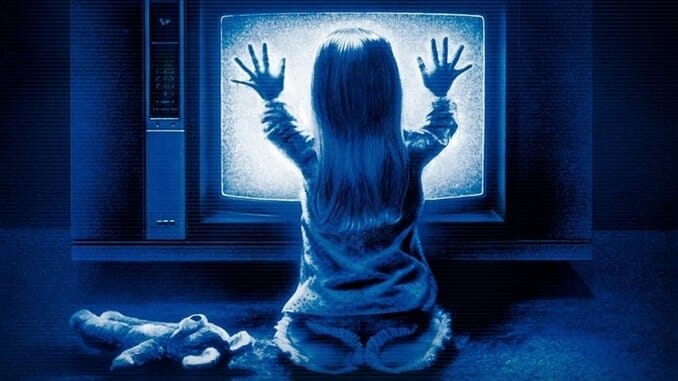
They’re heeeeeeeeeere… Steven Spielberg’s first big success in the producer’s chair (and notionally directed by Tobe Hooper) was released concurrently with ET: The Extraterrestrial and could arguably be seen as the dark side of a dyad about alienation in suburbia. Nonetheless, it retains the Spielberg Feel Good Stamp even as a horror film. The Freelings are a “typical” unassuming middle class family living in a peaceful suburb that becomes not-so-peaceful as the house is caught in the grip of supernatural disturbances. The pet canary dies. There are bizarre weather events. Youngest-kid Carol Ann (Heather O’Rourke) stands entranced in front of the TV in one of the most iconic moments in horror film history, lit by a mysterious beam of green light while the room begins to shake. As Carol Ann is repeatedly drawn to the television, where she begins to talk to “the TV people,” and eventually gets sucked into a dimensional vortex in the closet, father Steve (Craig T. Nelson) consults parapsychologist Dr. Lesh (Beatrice Straight). Lesh finds she’s in over her head and calls for an exorcist. The anatomization of the “happy family” is lavishly paced, making the ensuing horror all the more vivid. Not the deepest movie ever made, certainly, but an enduring classic of the genre, a highly detailed take on the “unassuming regular-Joe family savaged by invisible menace” trope, and still pretty damn creepy. —Amy Glynn
3. Kwaidan (1964)Director: Masaki Kobayashi
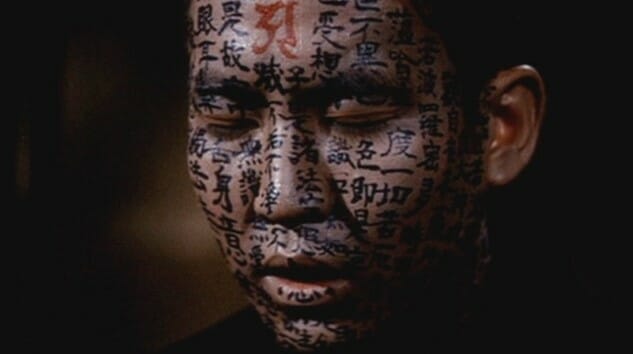
Ghost stories don’t get much more gorgeous than the four in Masaki Kobayashi’s sprawling Kwaidan. Between two acerbically political and widely lauded samurai epics, Hara-kiri (1962) and Samurai Rebellion (1967), Kobayashi led what was then Japan’s most expensive cinematic production ever, an anthology film with its parts loosely connected by Lafcadio Hearn’s collection of Japanese folk tales and Kobayashi’s intuitive penchant for surreal, sweepingly lush sets. In “The Black Hair,” a selfish, impoverished ronin (Rentaro Mikuni) abandons his wife to marry into wealth, only to realize he made a dire mistake, plunging him into a gothic nightmare of decay and regret. “The Woman of the Snow” follows a craftsman (the always welcome Tatsuya Nakadai) doomed to have everything he loves stolen from him by a patient bureaucratic specter. The movie-unto-itself, “Hoichi the Earless,” pits the titular blind monk musician (Katsua Nakamura) against a family of ghosts, forcing the bard to recite—in hushed, heartbreaking passages on the biwa—the story of their wartime demise. Rapt with indelible images (most well known, perhaps, is Hoichi’s skin completely covered in the script of The Heart Sutra to ward off the ghosts’ influence), “Hoichi the Earless” is both deeply unnerving and quietly tragic, wrung with the sadness of Kobayashi’s admission that only forces beyond our control hold the keys to our fates. The fourth, and by far the weirdest, entry, “In a Cup of Tea,” is a tale within a tale, purposely unfinished because the writer (Osamu Takizawa) who’s writing about a samurai (Noboru Nakaya) who keeps seeing an unfamiliar man (Kei Sato) in his cup of tea is in turn attacked by the malicious spirits he’s conjuring. From these disparate fairy tales, plenty of fodder for campfires, Kobayashi creates a mythos for his country’s haunted past: We are nothing if not the pawns of all those to come before. —Dom Sinacola
2. The Innocents (1961)Director: Jack Clayton

There are few sights in gothic horror more instantly iconic than the female protagonist, dressed in a flowing nightgown, wandering the halls of a pitch-black Victorian country mansion at midnight, flaming candelabra in hand, brushing cobwebs out of the way as she searches for the source of a mysterious sound. That’s Deborah Kerr in The Innocents, one of the greatest of all gothic chillers. Based on Henry James’ Turn of the Screw, it concerns the young governess with a love for children as she finds herself in a challenging new locale, caring for two orphaned kids whose rich uncle has no room in his heart for family members. From the opening moments, the ghostly presence of the past is palpable, and the stage is set thematically by the repeated musical motif of “O Willow Waly,” which is chilling to hear even without the context of the film. There’s a mystery to be unraveled here, but The Innocents is a cinematic feast even if you’re watching on mute, featuring cinematographer Freddie Francis’ experimentation with deep focus and loving shots of the country mansion that hides a secret past. The child actors, meanwhile, are nothing short of phenomenal—it may be the best performance by a couple of kids in the entire history of the genre. Martin Stephens in particular, as the troubled and oddly mature young boy Miles, is spellbinding, forcing Kerr’s Miss Giddens to question the possibility of supernatural influence from beyond the grave. It’s a beautiful ghost story best viewed by candlelight. —Jim Vorel
1. The Shining (1980)Director: Stanley Kubrick
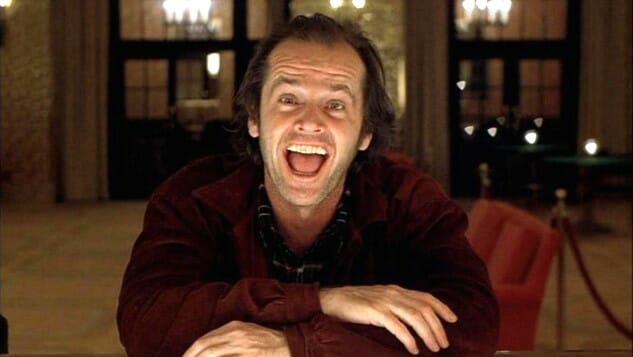
Stephen King famously hates Kubrick’s 1980 adaptation of his novel The Shining, which is difficult to understand until you actually read King’s original book, whereupon things become much more clear. Kubrick, ever the mad genius, largely rejected the emotional core of King’s story because he saw within the bones of The Shining an opportunity for a journey into the heart of visually and sonically inspired terror that few films have ever come close to replicating. Unlike in King’s novel, Jack (Jack Nicholson) is never treated with any kind of sympathy or pathos in the eyes of the audience—he’s a creep from the very first moment we meet him during his job interview, and he only gets worse from there, with the implied threat of his physical violence toward Danny (Danny Lloyd) and Wendy (Shelley Duvall) hanging over every scene like the sword of Damocles. His madness is alluded to masterfully through some of the most iconic visual and especially sound editing in cinema history—few horror films, or any film in general, has ever used sound as unnervingly as The Shining. Go watch The Witch, and the aural comparisons are obvious. This movie, like The Exorcist, seeps into your bones, infecting every perspective you have on the horror genre for the rest of a lifetime. It’s a monumental film. —Jim Vorel